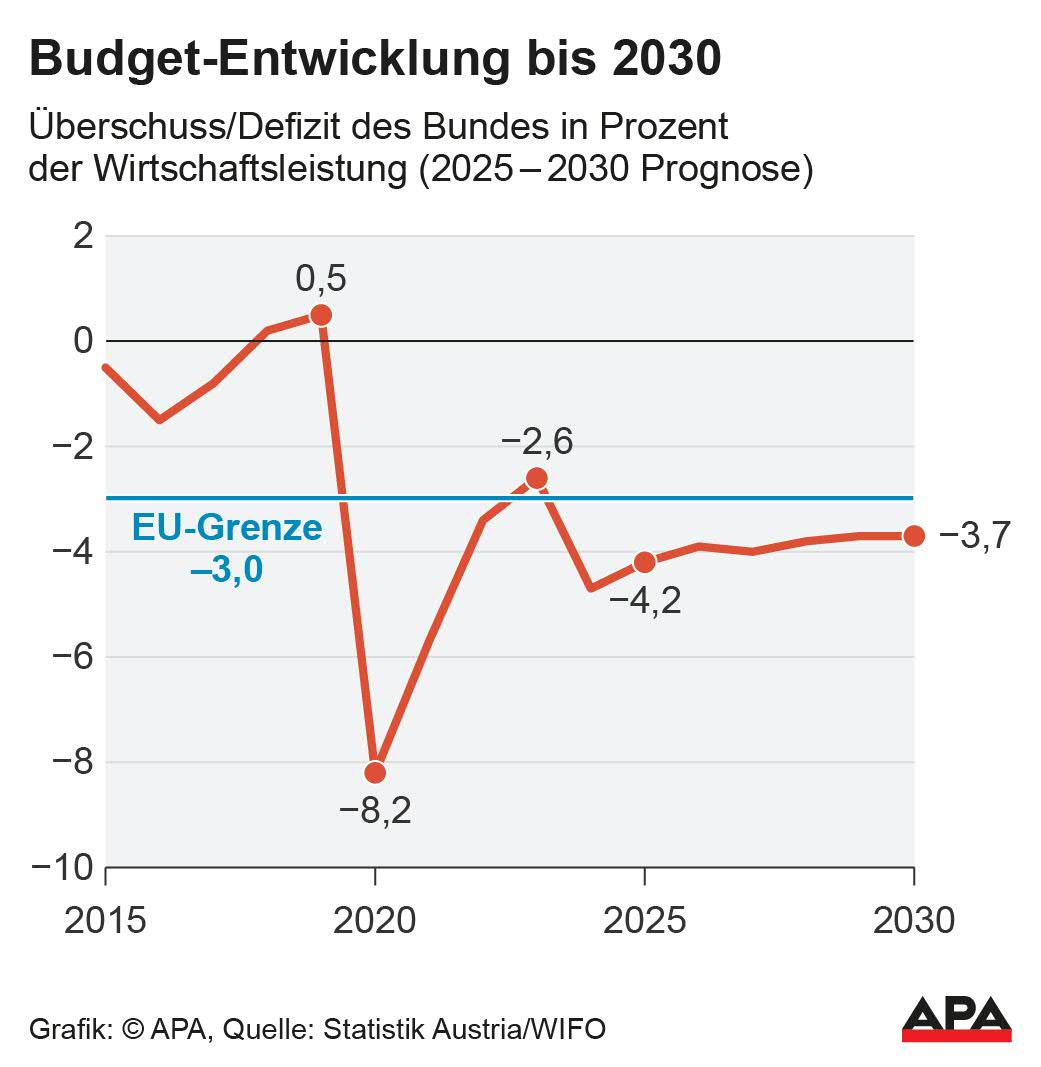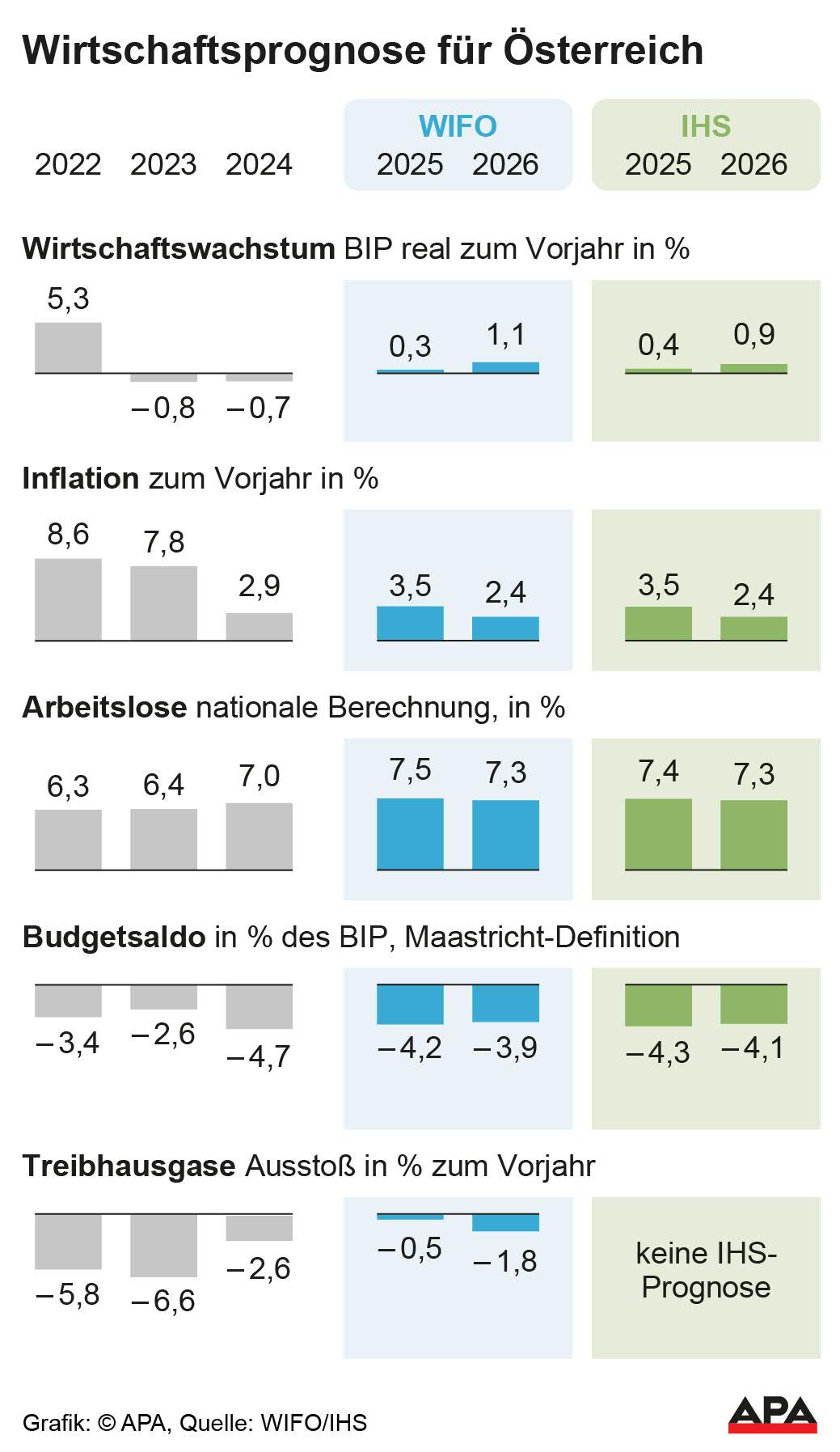Austria Overcomes Recession, But Inflation Remains High
The economic researchers from Wifo and IHS raised their economic forecast for the current year on Tuesday. In June, they still expected zero growth (Wifo) or a "mini" plus (IHS) of 0.1 percent for the domestic economy, but now a plus of 0.3 or 0.4 percent is expected. The longest economic downturn of the Second Republic will thus be history. Wifo and IHS cited a changed data basis as the reason for the forecast change. At the end of September, Statistics Austria revised the domestic GDP data for 2023, 2024, and the first half of 2025 upwards. Accordingly, the economic output in the previous two years did not shrink by a total of 2 percent as initially expected, but by 1.5 percent and grew slightly in the first half of the year.
Wifo Director Gabriel Felbermayr has renewed his warning of a lost decade for Austria's economy. Already in the spring, the top economist warned of such a scenario. According to the Wifo medium-term forecast presented on Tuesday, the real gross domestic product (GDP) per capita will not reach the value of 2019 again until 2030. "The picture is bleak," said Felbermayr. IHS head Holger Bonin also sees "no reason for all-clear."
The economic researchers from Wifo and IHS raised their economic forecast for the current year on Tuesday. In June, they still expected zero growth (Wifo) or a "mini" plus (IHS) of 0.1 percent for the domestic economy, but now a plus of 0.3 or 0.4 percent is expected. The longest economic downturn of the Second Republic will thus be history. In 2023, the GDP in Austria shrank by 0.8 percent and in 2024 by 0.7 percent.
Austria's Economy Shrunk Less Than Expected in 2023/24
Wifo and IHS cited a changed data basis as the reason for the forecast change. At the end of September, Statistics Austria revised the domestic GDP data for 2023, 2024, and the first half of 2025 upwards. Accordingly, the economic output in the previous two years did not shrink by a total of 2 percent as initially expected, but by 1.5 percent and grew slightly in the first half of 2025.
"No Reason for All-Clear"
"We are in a better position than thought in the summer. However, a real upswing is not in sight," commented the Wifo head on the current economic forecast. It is "time for a broad reform partnership" between companies, unions, and politics. In addition to combating inflation, Felbermayr also sees a great need for action in industrial policy. The industry has lost nearly 10 percent of real value added in recent years, and the industrial share of GDP has fallen by 2 percentage points to 15 percent since 2019. "A structural change is underway in the Austrian industry, which will intensify," said Wifo economist Josef Baumgartner.
IHS head Bonin also sees "no reason for all-clear" for Austria's economy. The growth rate is slower than in many other EU countries. "The pressure for reform remains high," said Bonin at the press event with Wifo. One must especially "get the inflation problem under control. "For this, various actors must step out of their comfort zones." The top economist advocated for "combating shortages" in the areas of housing, energy, and labor. "Such approaches have a long-term effect." Felbermayr and Bonin praised the current metalworkers' collective agreement below the inflation rate.
Consumption as a Driving Force
The overall government deficit in Austria in 2024 was 4.7 percent of the gross domestic product (GDP), significantly above the Maastricht threshold of 3 percent. In July, the initiation of an EU deficit procedure against Austria was officially decided.
"Considerable Uncertainties" in the Budgets of States and Municipalities

The forecast for budget development at the level of states and municipalities is "associated with considerable uncertainties," warned the IHS in its economic report. Approved austerity measures would relieve the budgets from the second half of 2025. Wifo expects expenditure savings by the public sector of nearly 3.5 billion euros in 2025, including the elimination of the climate bonus and the suspension of educational leave.
To ease the budget situation somewhat, Wifo head Gabriel Felbermayr again advocated for a reform of the property tax on Tuesday. Additional tax revenues could be generated here, which could later be passed on through a reduction in the real estate transfer tax. For budgetary reasons, Felbermayr is pushing for a small AMS reform. The aim is to reduce the "parking" of workers in unemployment insurance by companies. Voluntary breaks during job changes in unemployment insurance should also be reduced. IHS head Holger Bonin and Felbermayr again recommended that the government keep a close eye on social, health, and pension expenditures.

Reactions from Government, Social Partners, and Opposition
For Finance Minister Markus Marterbauer (SPÖ), Austria is "still one of the economically and socially strongest countries in the world." "If not us, who else should be able to solve the pressing economic problems," commented Marterbauer on the current Wifo/IHS forecast in a statement. Finance State Secretary Barbara Eibinger-Miedl (ÖVP) referred to the doubling of the investment allowance. This is "a central building block" to make the location more competitive and support the upswing. On the foundation laid by the federal government, further "sustainable reforms" could be implemented, said NEOS Deregulation State Secretary Josef Schellhorn.
FPÖ economic spokesperson Barbara Kolm criticized the economic policy of the ÖVP/SPÖ/NEOS government and called for a focus on "performance, entrepreneurial spirit, and reliability." SPÖ budget spokesperson Jan Krainer sees the public sector debt reduction "on track." NEOS economic spokesperson Markus Hofer advocated for "ambitious structural reforms."
The Secretary General of the Austrian Economic Chamber (WKÖ), Jochen Danninger, called for "the reduction of bureaucratic burdens, more efficiency in state funding structures, and the securing of internationally competitive framework conditions" in light of the economic forecast. AK chief economist Matthias Schnetzer is pushing for a qualification offensive for employees and the unemployed, as well as more age-appropriate jobs, including a bonus-malus system for companies. ÖGB federal manager Helene Schuberth insists on "targeted impulses for employment, demand, and industry."
(APA/Red)
Wifo und IHS prognostizieren zudem für heuer ein gesamtstaatliches Defizit von 4,2 bzw. 4,3 Prozent der Wirtschaftsleistung und von 3,9 bzw. 4,1 Prozent im kommenden Jahr. Finanzminister Markus Marterbauer (SPÖ) ist etwas pessimistischer und meldete vergangene Woche für 2025 ein erwartetes Budgetdefizit von 4,54 Prozent an die EU.
Das gesamtstaatliche Defizit in Österreich lag 2024 mit 4,7 Prozent des Bruttoinlandsprodukts (BIP) deutlich über dem Maastricht-Grenzwert von 3 Prozent. Im Juli wurde deswegen die Eröffnung eines EU-Defizitverfahrens gegen Österreich offiziell beschlossen.
"Beträchtlichen Unsicherheiten" bei Budget der Länder und Gemeinden
Die Prognose der Budgetentwicklung auf Ebene der Länder und Gemeinden sei "mit beträchtlichen Unsicherheiten verbunden", warnte das IHS in seinem Konjunkturbericht. Beschlossene Sparmaßnahmen würden die Budgets ab der zweiten Jahreshälfte 2025 entlasten. Das Wifo rechnet für 2025 mit ausgabenseitigen Einsparungen der öffentlichen Hand von knapp 3,5 Mrd. Euro, unter anderem durch die Streichung des Klimabonus und der Aussetzung der Bildungskarenz.
Um die Budgetlage etwas zu entspannen, plädierte Wifo-Chef Gabriel Felbermayr am Dienstag erneut für eine Reform der Grundsteuer. Hier könne man zusätzliche Steuermittel lukrieren, die später auch durch eine Reduktion der Grunderwerbssteuer weitergegeben werden könne. Aus budgetären Gründen drängt Felbermayr auf eine kleine AMS-Reform. Es gehe darum, das "Parken" von Arbeitskräften in der Arbeitslosenversicherung durch Unternehmen zu reduzieren. Auch "freiwillige Pausen" bei Jobwechsel in der Arbeitslosenversicherung müsse man reduzieren. IHS-Chef Holger Bonin und Felbermayr empfahlen der Regierung erneut, die Sozial-, Gesundheits- und Pensionsausgaben genau im Blick zu behalten.
Reaktionen von Regierung, Sozialpartner und Opposition
Für Finanzminister Markus Marterbauer (SPÖ) ist Österreich "nach wie vor eines der wirtschaftlich und sozial stärksten Länder der Welt". "Wem, wenn nicht uns, soll es gelingen die drängenden wirtschaftlichen Probleme zu lösen", kommentierte Marterbauer die aktuelle Wifo/IHS-Prognose in einer Aussendung. Finanzstaatssekretärin Barbara Eibinger-Miedl (ÖVP) verwies auf die Verdoppelung des Investitionsfreibetrages. Dies sei "ein zentraler Baustein", um den Standort wettbewerbsfähiger zu machen und den Aufschwung zu unterstützen." Auf dem von der Bundesregierung gelegten Fundament könne man weitere "nachhaltige Reformen" umsetzen, so NEOS-Deregulierungsstaatssekretär Josef Schellhorn.
FPÖ-Wirtschaftssprecherin Barbara Kolm kritisierte die Wirtschaftspolitik der ÖVP/SPÖ/NEOS-Regierung und forderte einen Fokus auf "Leistung, Unternehmergeist und Handschlagqualität". SPÖ-Budgetsprecher Jan Krainer sieht den Schuldenabbau der öffentlichen Hand "auf Kurs". NEOS-Wirtschaftssprecher Markus Hofer plädierte für "ambitionierten Strukturreformen".
Der Generalsekretär der Wirtschaftskammer Österreich (WKÖ), Jochen Danninger, forderte angesichts der Konjunkturprognose "den Abbau bürokratischer Belastungen, mehr Effizienz in staatlichen Förderstrukturen und die Sicherung international wettbewerbsfähiger Rahmenbedingungen. AK-Chefökonom Matthias Schnetzer drängt unter anderem auf eine Qualifizierungsoffensive für Beschäftigte und Arbeitslose sowie mehr altersgerechte Arbeitsplätze inklusive Bonus-Malus-System für Unternehmen. ÖGB-Bundesgeschäftsführerin Helene Schuberth pocht auf "gezielte Impulse für Beschäftigung, Nachfrage und Industrie".
(APA/Red)
This article has been automatically translated, read the original article here.





